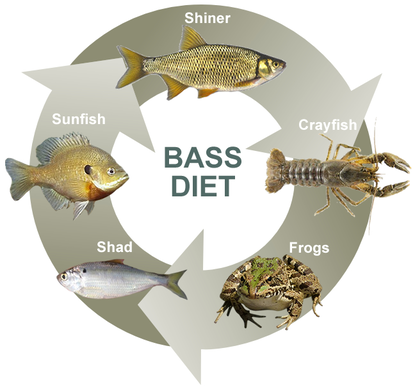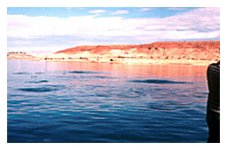Table of Contents
Toggle
With bass ranging so far around the world and in so many different bodies of water, a common question is, “how to know what bass are feeding on?”
Bass feed on just about anything they can fit in their mouth. When you are bass fishing, matching the hatch makes makes all the difference, so it is important to know exactly what bass are feeding on.
The vast majority of lakes and ponds have the same general bass forage available. These being:

The first way to tell what bass are eating is to look at their teeth. If bass are feeding primarily on baitfish, they will have longer, shorter teeth.
This is because baitfish are relatively soft, and bass will swallow them in one quick gulp. This doesn’t damage or file down the teeth which allows them to grow out.
On the other hand, if the bass have very short, filed down teeth that are more like sand paper, the bass are most likely feeding on crawfish.
Crawfish are very tough and take a while to swallow. This leads to the filing down of the teeth. Bass feeding on crawfish will also tent to have a reddish coloration on their teeth.
Since bass will eat anything they can fit into their huge mouths, whatever is the most available forage, will be what bass are feeding on the most.
Next time you are fishing, take a close look around the bank or on your fish finder to see what is around.
My local pond has tons of sunfish and shad. So the bass in my pond mostly feed on sunfish and shad.
The bass if my pond also feed on lots of frogs. Every time I walk down the bank, I scare numerous frogs into jumping in the water.
However, my pond has very few crawfish. So the bass don’t feed much on crawfish, and I am much better off using lures that mimic baitfish.
If you are unsure if your lake has crawfish or not, look all around the shore.
If there are crawfish in the lake, the shore will have lots of mounds all around the bank. Especially behind the more rocky areas of the bank.
Crawfish mounds look like this:


This is certainly not my favorite option and should not be misused. If you truly have no idea what the bass are eating, they you can cut it open and check exactly what is inside its stomach.
The food that is still in the bass’s stomach will usually not be very digested. This means you will still be able to tell what kind of things the bass has been eating.
Again, I only recommend this as a resort because I don’t think it is good to kill fish without either using them as food or bait.

In the spring months, bass feed heavily on crawfish and shad. Crawfish and shad tend to be more active and abundant during the early spring, making them very sought after in these months.
During the hot summer months, there is an abundant amount of sunfish, frogs, insects, and miscellaneous creatures like worms, rats, small birds, and other things.
The summer months bring many food sources with it, but the big three are sunfish, frogs, and insects.
The fall moths are a feeding frenzy for bass as they prepare for the winter. Bass are looking for bigger meals to fatten up on.
Bluegill and baby bass will be the main forage during the fall. The baby bass are about 6 months old at this point, making them the perfect sized meal for hungry bass.
Shad will again be the primary forage for winter bass. More specifically, dead or dying shad.
Bass have very little energy in the winter and can’t afford to spend it chasing prey. In the winter, huge amounts of shad die off and sink to the bottom.
These dead or dying shad are a quick and easy meal for bass.
Unless you have a fish finder and a boat, it can often be hard to tell if a lake even has shad in it. Look for schools of shad boiling on the surface of the lake.
Shad typically do this in the summer time when there is a lot of algae and little bugs on the surface.

Another great way to find shad is to go to your lake during a warm front in the winter time.
Find a cove or stream like outlet in you lake that is very shallow. Shad don’t like the cold of winter, so during a warm front, they often swim into shallow waters that warm up faster.
Take note of all the bass you catch and what you caught them on. If you catch most of your bass on bluegill imitations, the bass are feeding on bluegill.
If you catch most of your bass on crawfish imitations, the bass are feeding on crawfish. I think you get the point. Whatever you are catching fish on, is what the fish are eating.
So, there you have it – your guide to deciphering what’s on the bass menu. By tuning into their environment, diet, and behavior, you’re ready to rock the fishing game.
Remember, it’s a dynamic performance out there, with bass changing their tastes as the seasons roll by.
But armed with these insights, your lure becomes a spotlight, and your technique the perfect pitch.
Keep that fishing journal handy – it’s your backstage pass to trends and triumphs. And don’t go solo; the fishing community’s your jam session for trading tips and tales.
